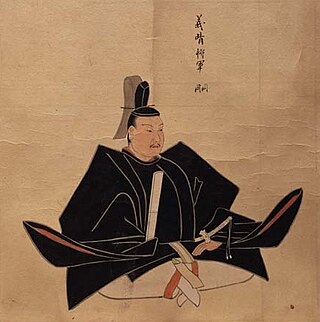| Part of a series on the |
| History of Japan |
|---|
 |
Kyōroku (享禄) was a Japanese era name (年号, nengō, "year name") after Daiei and before Tenbun . This era spanned from August 1528 to July 1532. [1] The reigning emperor was Go-Nara -tennō (後奈良天皇). [2]
| Part of a series on the |
| History of Japan |
|---|
 |
Kyōroku (享禄) was a Japanese era name (年号, nengō, "year name") after Daiei and before Tenbun . This era spanned from August 1528 to July 1532. [1] The reigning emperor was Go-Nara -tennō (後奈良天皇). [2]


Ashikaga Yoshiharu was the twelfth shōgun of the Ashikaga shogunate from 1521 through 1546 during the late Muromachi period of Japan. He was the son of the eleventh shōgun Ashikaga Yoshizumi.

Emperor Go-Nara was the 105th Emperor of Japan, according to the traditional order of succession. He reigned from June 9, 1526, until his death in 1557, during the Sengoku period of the Muromachi Bakufu. His personal name was Tomohito (知仁).

Tenbun (天文), also known as Tenmon, was a Japanese era name after Kyōroku and before Kōji. This period spanned from July 1532 through October 1555. The reigning emperor was Go-Nara-tennō (後奈良天皇).

Daiei (大永), also known as Taiei or Dai-ei, was a Japanese era name after Eishō and before Kyōroku. This period spanned the years from August 1521 through August 1528. The reigning emperors were Go-Kashiwabara-tennō (後柏原天皇) and Go-Nara-tennō (後奈良天皇).

Chōkyō (長享) was a Japanese era name after Bunmei and before Entoku. This period spanned the years from July 1487 through August 1489. The reigning emperor was Go-Tsuchimikado-tennō (後土御門天皇).

Bunmei was a Japanese era name after Ōnin and before Chōkyō. This period spanned from April 1469 through July 1487. The reigning emperor was Go-Tsuchimikado-tennō (後土御門天皇).

Bun'an (文安) was a Japanese era name after Kakitsu and before Hotoku. This period spanned the years from February 1444 through July 1449. The reigning emperor was Go-Hanazono-tennō (後花園天皇).

Karoku (嘉禄) was a Japanese era name after Gennin and before Antei. This period spanned the years from April 1225 to December 1227. The reigning emperor was Go-Horikawa-tennō (後堀河天皇).

Kōwa (弘和) was a Japanese era name of the Southern Court during the Era of Northern and Southern Courts after Tenju and before Genchū. This period spanned the years from February 1381 to April 1384. The Southern Court emperors in Yoshino during this time-frame were Emperor Chōkei and Emperor Go-Kameyama. The Northern court emperors in Kyoto were Emperor Go-En'yū and Emperor Go-Komatsu

Shōchū (正中) was a Japanese era name after Genkō and before Karyaku. This period spanned the years from December 1324 to April 1326. The reigning Emperor was Go-Daigo-tennō (後醍醐天皇).

Gen'ō (元応) was a Japanese era name after Bunpō and before Genkō. This period spanned the period from April 1319 through February 1321. The reigning Emperor was Go-Daigo-tennō (後醍醐天皇).

Kakei (嘉慶) was a Japanese era name of the Northern Court during the Era of Northern and Southern Courts after Shitoku and before Kōō. This period spanned the years from August 1387 to February 1389. The emperor in Kyoto was Emperor Go-Komatsu The Southern Court rival in Yoshino during this time-frame was Emperor Go-Kameyama.

Angen (安元) was a Japanese era name after Jōan and before Jishō. This period spanned the years from July 1175 through August 1177. The reigning emperor was Takakura-tennō (高倉天皇).

Tenryaku (天暦) was a Japanese era name after Tengyō and before Tentoku. This period spanned the years from April 947 through October 957. The reigning emperor was Murakami-tennō (村上天皇).

Tenroku (天禄) was a Japanese era after Anna and before Ten'en. This period spanned the years from March 970 through March 973. The reigning emperors were Reizei-tennō (冷泉天皇) and En'yū-tennō (円融天皇).

Hōgen (保元) was a Japanese era name after Kyūju and before Heiji. This period spanned the years from April 1156 through April 1159. The reigning emperors were Emperor Go-Shirakawa-tennō (後白河天皇) and Emperor Nijō-tennō (二条天皇).

Kowa (康和) was a Japanese era name after Jōtoku and before Chōji. This period spanned the years from August 1099 through February 1104. The reigning emperor was Horikawa-tennō (堀河天皇).

Enbun (延文), also transcribed Embun, was a Japanese era name of the Northern Court during the Era of Northern and Southern Courts after Bunna and before Kōan. This period spanned the years from March 1356 through March 1361; The emperor in Kyoto was Emperor Go-Kōgon. Go-Kōgon's Southern Court rival in Yoshino during this time-frame was Emperor Go-Murakami

Jōwa (貞和) was a Japanese era or nengō which was promulgated by the more militarily powerful of two Imperial rival courts during the Era of Northern and Southern Courts. This nengō came after Kōei and before Kannō and lasted from October 1345 through February 1350. The emperor in Kyoto was Emperor Kōmyō. Go-Kōgon's Southern Court rival in Yoshino during this time-frame was Emperor Go-Murakami.

Kōei (康永) was a Japanese era name of the Northern Court during the Era of Northern and Southern Courts after Ryakuō and before Jōwa. This period spanned the years from April 1342 to October 1345. The emperor in Kyoto was Emperor Kōmyō. Go-Kōgon's Southern Court rival in Yoshino during this time-frame was Emperor Go-Murakami.